In today’s data-driven world, organizations are drowning in an ocean of information. Extracting valuable insights from this vast sea of data is crucial for driving business growth and making informed decisions. This is where big data analytics tools come into play. These powerful tools empower businesses to analyze massive datasets, uncover hidden patterns, and gain a deeper understanding of customer behavior, market trends, and operational efficiencies.
From real-time customer insights to predictive maintenance and personalized marketing campaigns, big data analytics has the potential to revolutionize every aspect of your business. By leveraging the right tools, you can unlock the true power of your data and gain a competitive edge in the marketplace. This article will explore the key features and benefits of big data analytics tools, providing you with a comprehensive guide to selecting the right solution for your organization’s specific needs.
What is Big Data Analytics?
In today’s data-driven world, organizations are inundated with an overwhelming volume of data, often referred to as big data. This vast amount of information, encompassing structured and unstructured formats, holds immense potential for extracting valuable insights and driving strategic decisions.
Big data analytics is the process of examining, cleaning, transforming, and analyzing large and complex datasets to uncover hidden patterns, trends, and correlations. It involves utilizing advanced tools and techniques to extract meaningful information from raw data, enabling organizations to make data-driven decisions, improve efficiency, and gain a competitive edge.
Big data analytics encompasses various techniques, including:
- Descriptive Analytics: Summarizing past data to understand what has happened.
- Diagnostic Analytics: Exploring the “why” behind patterns and trends identified through descriptive analytics.
- Predictive Analytics: Forecasting future outcomes based on historical data and patterns.
- Prescriptive Analytics: Recommending actions or solutions based on insights derived from data analysis.
By harnessing the power of big data analytics, organizations can gain a deeper understanding of their customers, optimize their operations, identify new business opportunities, and enhance their overall decision-making processes.
Benefits of Big Data Analytics
Big data analytics is the process of examining large datasets to identify trends, patterns, and insights. This information can be used to improve business operations, make better decisions, and gain a competitive advantage.
Here are some of the key benefits of big data analytics:
- Improved decision-making: Big data analytics can provide businesses with insights that can help them make better decisions. By understanding customer behavior, market trends, and other key data points, businesses can make more informed choices about product development, marketing campaigns, and other strategic initiatives.
- Increased efficiency: Big data analytics can help businesses to identify areas where they can improve efficiency. For example, businesses can use big data to optimize their supply chains, improve customer service, and reduce costs.
- Enhanced customer experience: Big data analytics can help businesses to better understand their customers and provide them with a more personalized experience. By tracking customer behavior and preferences, businesses can tailor their products and services to meet the specific needs of their customers.
- New product and service development: Big data analytics can help businesses to identify new product and service opportunities. By analyzing customer data, businesses can identify emerging trends and develop products and services that meet the needs of their target market.
- Competitive advantage: Businesses that are able to effectively leverage big data analytics can gain a competitive advantage over their rivals. By using big data to make better decisions, improve efficiency, and enhance customer experience, businesses can outperform their competitors and achieve greater success.
In conclusion, big data analytics offers a wide range of benefits for businesses of all sizes. By leveraging the power of big data, businesses can improve their decision-making, increase efficiency, enhance customer experience, develop new products and services, and gain a competitive advantage.
Types of Big Data Analytics Tools
Big data analytics tools are essential for businesses to extract meaningful insights from vast amounts of data. These tools offer a wide range of capabilities, from data collection and storage to analysis and visualization. Understanding the different types of big data analytics tools is crucial for choosing the right tools for your specific needs. Here’s a breakdown of the major categories:
1. Data Ingestion and Storage Tools
These tools are responsible for collecting and storing raw data from various sources. They handle large volumes of data and ensure its availability for analysis. Some popular examples include:
- Apache Kafka: A real-time streaming platform for ingesting and processing high-volume data streams.
- Apache Hadoop: A distributed storage and processing framework designed for handling massive datasets.
- Amazon S3: A cloud-based object storage service for storing and managing large amounts of data.
2. Data Processing and Transformation Tools
These tools process and transform raw data into a format suitable for analysis. They involve tasks like data cleaning, aggregation, and feature engineering.
- Apache Spark: A fast and general-purpose cluster computing framework for large-scale data processing.
- Apache Pig: A high-level data flow language for processing large datasets in Hadoop.
- SQL (Structured Query Language): A standard language for querying and manipulating data stored in relational databases.
3. Data Analysis and Modeling Tools
These tools are used to analyze data and build predictive models. They enable businesses to uncover patterns, trends, and insights from their data.
- R: A powerful statistical computing language and environment for data analysis.
- Python: A versatile programming language with extensive libraries for data science and machine learning.
- SAS: A comprehensive analytics suite offering a wide range of tools for data analysis and modeling.
4. Data Visualization and Reporting Tools
These tools help communicate data insights in an easily understandable format. They enable businesses to visualize data trends and create interactive reports.
- Tableau: A powerful data visualization platform for creating interactive dashboards and reports.
- Power BI: A business intelligence tool for creating interactive visualizations and dashboards.
- D3.js: A JavaScript library for creating dynamic and interactive data visualizations for web pages.
Choosing the right big data analytics tools depends on factors such as the size and complexity of your data, your analytical needs, and your budget. By leveraging the right tools, businesses can unlock valuable insights, drive data-driven decisions, and gain a competitive advantage.
Key Features to Consider
Big data analytics tools are essential for businesses looking to extract valuable insights from their massive datasets. These tools empower organizations to make informed decisions, optimize operations, and gain a competitive edge. When choosing a big data analytics tool, it’s crucial to consider several key features to ensure it meets your specific needs.
Data Ingestion and Processing
The tool should be capable of ingesting data from diverse sources, including databases, files, APIs, and streaming platforms. It should also efficiently process large volumes of data in real-time or near real-time to keep up with the demands of modern businesses.
Data Storage and Management
A reliable storage system is vital for managing your data. The tool should offer scalable storage options, ensuring that you can accommodate growing data volumes. It should also provide data governance features to ensure data security and compliance.
Data Analysis and Visualization
The tool should offer a comprehensive suite of analytical functions for exploring, cleaning, transforming, and analyzing data. It should also provide visualization capabilities for creating insightful charts, graphs, and dashboards that communicate complex data patterns effectively.
Machine Learning and AI
For advanced analytics, consider tools with built-in machine learning algorithms and artificial intelligence capabilities. These features can help you discover hidden patterns, predict future trends, and automate tasks, ultimately enhancing your decision-making processes.
Collaboration and Sharing
The tool should facilitate collaboration among team members by providing features for sharing reports, dashboards, and insights. It should also offer secure access controls to protect sensitive data.
Integration and Extensibility
The tool should seamlessly integrate with existing systems and applications, such as databases, business intelligence tools, and reporting platforms. It should also be extensible, allowing you to customize its functionality to meet your specific requirements.
By carefully considering these key features, you can choose a big data analytics tool that empowers you to unlock valuable insights from your data and drive business value.
Popular Big Data Analytics Platforms
The world of data analytics is constantly evolving, with new tools and platforms emerging regularly. As businesses generate more data than ever before, it’s crucial to have the right tools to analyze, interpret, and extract valuable insights from this massive amount of information. This is where big data analytics platforms come in, providing a comprehensive suite of features for storing, processing, and analyzing massive datasets.
Here are some of the most popular big data analytics platforms used today:
- Hadoop: A popular open-source framework designed for distributed storage and processing of large datasets. It’s highly scalable and provides a reliable foundation for building big data solutions.
- Apache Spark: A fast and general-purpose cluster computing framework known for its in-memory processing capabilities. Spark can handle real-time data analysis and is widely used for machine learning and graph processing.
- Cloudera: A commercial platform built on Hadoop, offering a comprehensive ecosystem for managing and analyzing data. Cloudera’s platform provides a unified environment for data warehousing, data lakes, and real-time analytics.
- Amazon Web Services (AWS): AWS offers a wide range of cloud-based big data analytics services, including Amazon S3 for data storage, Amazon EMR for Hadoop and Spark processing, and Amazon Redshift for data warehousing.
- Microsoft Azure: Azure provides a similar suite of cloud-based big data analytics services, including Azure Data Lake Storage, Azure HDInsight for Hadoop and Spark, and Azure Synapse Analytics for data warehousing.
- Google Cloud Platform (GCP): GCP also offers a robust set of big data analytics tools, including Google Cloud Storage, Google Dataproc for Hadoop and Spark, and BigQuery for data warehousing.
These platforms offer various features and capabilities to cater to different business needs and data volumes. When selecting a platform, consider factors like scalability, cost, ease of use, integration with existing systems, and specific analytics requirements. Choosing the right big data analytics platform can significantly impact your organization’s ability to unlock valuable insights, make informed decisions, and drive business value.
Data Visualization and Reporting
Data visualization and reporting are crucial components of big data analytics. They transform raw data into meaningful and actionable insights, enabling businesses to make informed decisions and drive positive outcomes. Effective data visualization tools provide intuitive dashboards, interactive charts, and compelling narratives that convey complex data patterns in a clear and concise manner. These tools empower analysts and business users to explore data trends, identify correlations, and gain a deeper understanding of their business performance.
Through data visualization, businesses can:
- Identify trends and patterns: Spot emerging trends, seasonality, and outliers in data sets.
- Discover hidden relationships: Uncover connections and correlations between different variables.
- Communicate insights effectively: Present complex data in a simple and understandable format to stakeholders.
- Track key metrics: Monitor progress towards goals and identify areas for improvement.
- Promote data-driven decision-making: Support informed decision-making by providing clear and compelling data-backed evidence.
Modern big data analytics tools offer sophisticated visualization capabilities that go beyond basic charts and graphs. They incorporate interactive features, such as drill-down capabilities, filtering options, and dynamic updates, allowing users to explore data in real-time and gain deeper insights. These tools also enable the creation of customized reports that cater to specific business needs, presenting data in a way that aligns with different stakeholder perspectives.
In conclusion, data visualization and reporting are indispensable components of big data analytics, playing a vital role in unlocking insights and driving business value. By transforming raw data into meaningful narratives, businesses can gain a competitive edge, make data-driven decisions, and achieve their strategic goals.
Integrating Big Data with Existing Systems
Integrating big data with existing systems is a crucial step in unlocking its true value. This involves connecting your big data analytics platform with your existing databases, applications, and business processes. This integration allows you to leverage the insights derived from big data analysis to inform and improve your existing operations.
There are several approaches to integration:
- Data Pipelines: These automated processes extract, transform, and load (ETL) data from your source systems into your big data platform. This ensures a continuous flow of relevant data for analysis.
- API Integration: Application Programming Interfaces (APIs) allow your big data platform to interact directly with other systems, enabling real-time data exchange and triggering actions based on analysis results.
- Data Federation: This approach avoids moving data by creating virtual views of data across different systems. This enables analysis without compromising data security or impacting source system performance.
Successful integration requires careful planning and consideration of factors like data consistency, security, and performance. By integrating your big data platform with your existing systems, you can optimize your business processes, improve decision-making, and unlock the full potential of your data assets.
Use Cases Across Industries
Big data analytics tools are revolutionizing how businesses operate across various industries. By leveraging these tools, organizations can unlock valuable insights from vast datasets, leading to improved decision-making, enhanced operational efficiency, and ultimately, increased business value.
Retail
In retail, big data analytics can be used to understand customer behavior, personalize marketing campaigns, optimize inventory management, and predict demand trends. For example, retailers can analyze customer purchase history, website browsing data, and social media activity to identify buying patterns and offer targeted promotions. This data-driven approach can lead to higher customer satisfaction and increased sales.
Healthcare
The healthcare industry is heavily reliant on big data analytics for improving patient outcomes, optimizing treatment plans, and developing new drugs. By analyzing patient medical records, genomic data, and clinical trial results, healthcare providers can identify risk factors, predict disease progression, and develop personalized treatment strategies. This can lead to more effective disease management, reduced healthcare costs, and improved patient care.
Finance
Financial institutions use big data analytics to detect fraud, assess risk, and make investment decisions. By analyzing transaction data, credit history, and market trends, banks and investment firms can identify suspicious activity, evaluate loan applications, and make informed investment choices. This data-driven approach can help mitigate financial risk and improve profitability.
Manufacturing
In manufacturing, big data analytics can be used to optimize production processes, improve quality control, and reduce downtime. By analyzing sensor data from machines, production lines, and supply chains, manufacturers can identify potential bottlenecks, predict equipment failure, and optimize resource allocation. This can lead to increased efficiency, reduced costs, and improved product quality.
Energy
The energy industry is using big data analytics to manage energy consumption, optimize grid performance, and develop renewable energy sources. By analyzing data from smart meters, weather forecasts, and energy production facilities, energy companies can identify patterns in energy demand, optimize grid efficiency, and develop new energy solutions. This can lead to reduced energy costs, increased reliability, and a more sustainable energy system.
These are just a few examples of how big data analytics tools are transforming industries. As the volume and complexity of data continue to grow, the potential for these tools to drive innovation and create business value will only increase.
Choosing the Right Big Data Analytics Tool
In the realm of big data, extracting valuable insights from vast amounts of information is crucial for businesses to stay competitive and make informed decisions. With a plethora of big data analytics tools available, selecting the right one for your specific needs can be a daunting task. This article will guide you through the key factors to consider when choosing the right big data analytics tool for your business.
1. Data Sources and Volume: The first step is to assess your data sources and the volume of data you need to analyze. Some tools excel at handling structured data from databases, while others are better suited for unstructured data from social media, web logs, or sensor networks. The tool’s ability to handle the scale and complexity of your data is paramount.
2. Analytics Requirements: Determine the type of analyses you need to perform, such as predictive modeling, sentiment analysis, or real-time reporting. Different tools offer specialized capabilities and functionalities. For example, if you need advanced machine learning algorithms, choose a tool that supports them.
3. User Skills and Expertise: Consider the technical skills and experience of your team. Some tools are user-friendly and require minimal coding expertise, while others demand advanced programming knowledge. The tool’s learning curve and ease of use are crucial for adoption and success.
4. Integration and Compatibility: Ensure the tool integrates well with your existing systems and applications. Compatibility with your data sources, databases, and business intelligence platforms is essential for seamless data flow and analysis.
5. Budget and Scalability: Evaluate the tool’s pricing model, licensing fees, and cloud-based options. Consider your budget constraints and the potential for scalability as your data volume grows.
6. Security and Compliance: Data security and privacy are paramount. Choose a tool that meets your industry-specific compliance requirements and offers robust security features to protect sensitive information.
7. Vendor Support and Community: The vendor’s reputation, support services, and community resources are crucial for ongoing maintenance and troubleshooting. Choose a vendor that offers reliable support and a vibrant community for sharing knowledge and best practices.
By carefully considering these factors, you can choose the right big data analytics tool that empowers your business to unlock valuable insights, drive informed decisions, and gain a competitive edge in the data-driven world.
Data Security and Governance
In the era of big data, where organizations are collecting and analyzing vast amounts of data to gain valuable insights, ensuring data security and governance is paramount. These principles are essential to protect sensitive information, comply with regulations, and maintain trust with customers and stakeholders.
Data security involves safeguarding data from unauthorized access, use, disclosure, disruption, modification, or destruction. It encompasses various measures, including:
- Access controls: Limiting access to authorized personnel and roles.
- Encryption: Transforming data into an unreadable format to protect it during transmission and storage.
- Data masking: Hiding sensitive information from unauthorized users while preserving data integrity.
- Security monitoring: Continuously tracking and analyzing data access patterns and potential security threats.
Data governance establishes policies, procedures, and responsibilities for managing data throughout its lifecycle. It ensures that data is accurate, consistent, and compliant with regulations. Key aspects of data governance include:
- Data quality management: Defining and enforcing standards for data accuracy, completeness, and consistency.
- Data retention policies: Establishing rules for data storage and disposal to meet legal and regulatory requirements.
- Data lineage tracking: Tracing the origin and transformations of data to enhance accountability and data integrity.
- Data privacy compliance: Adhering to data protection regulations such as GDPR and CCPA to safeguard personal information.
By implementing strong data security and governance practices, organizations can:
- Protect sensitive data from breaches and unauthorized access.
- Meet regulatory compliance requirements, avoiding fines and legal issues.
- Enhance data quality and reliability, improving the accuracy of analytics and decision-making.
- Build trust with customers and stakeholders by demonstrating a commitment to data security and ethical practices.
Hadoop and Spark for Big Data Processing
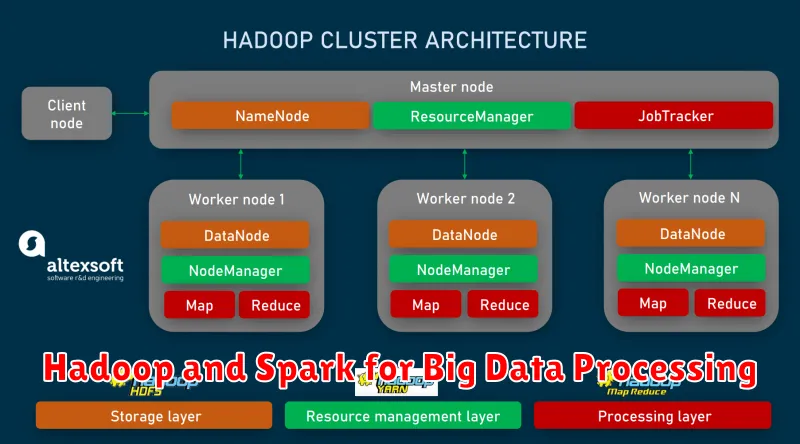
In the realm of big data analytics, efficient processing and analysis are paramount. Two prominent tools that have revolutionized big data processing are Hadoop and Spark. These frameworks offer distinct strengths and cater to different requirements, empowering organizations to extract valuable insights from massive datasets.
Hadoop, a distributed file system and processing framework, excels in handling vast amounts of data in a fault-tolerant manner. Its core components, Hadoop Distributed File System (HDFS) and MapReduce, enable data storage and parallel processing across a cluster of nodes. Hadoop is particularly well-suited for batch processing tasks, where large datasets are analyzed periodically to generate insights.
Spark, on the other hand, is a general-purpose distributed processing engine that prioritizes speed and versatility. Its in-memory processing capabilities allow for significantly faster data analysis compared to Hadoop’s disk-based approach. Spark supports various processing paradigms, including batch processing, real-time stream processing, and interactive queries, making it a versatile choice for diverse analytical tasks.
The choice between Hadoop and Spark depends on the specific requirements of the big data processing task. For batch processing of massive datasets, Hadoop’s fault tolerance and scalability make it a suitable option. Conversely, Spark shines in applications demanding low latency, real-time analytics, and interactive exploration of data.
By harnessing the power of these frameworks, organizations can gain a competitive edge by unlocking valuable insights from their data, driving better decision-making, and improving operational efficiency.
Cloud-Based Big Data Analytics Solutions
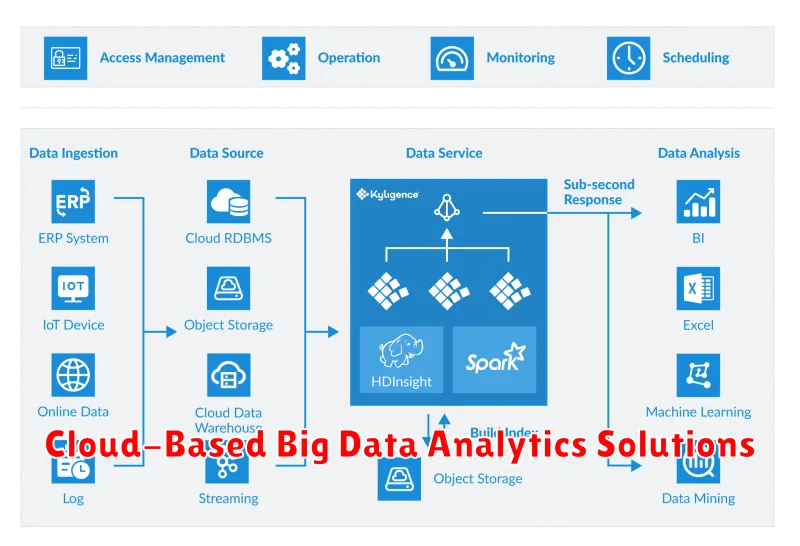
In today’s data-driven world, businesses are constantly seeking ways to gain valuable insights from their vast data stores. Cloud-based big data analytics solutions have emerged as a powerful and scalable approach to unlock these insights, enabling organizations to make data-driven decisions and drive business value.
Cloud platforms offer a range of benefits for big data analytics, including:
- Scalability and Elasticity: Cloud infrastructure can be easily scaled up or down to meet fluctuating data volumes and processing demands.
- Cost-Effectiveness: Pay-as-you-go pricing models eliminate the need for upfront capital investments in hardware and software.
- Flexibility and Agility: Cloud solutions provide access to a wide range of tools and services, allowing businesses to adapt to changing requirements quickly.
- Enhanced Security: Cloud providers invest heavily in security measures, ensuring data protection and compliance.
Leading cloud providers like AWS, Azure, and Google Cloud offer comprehensive big data analytics platforms with a wide array of services, such as:
- Data Warehousing and Data Lakes: Securely store and manage massive datasets.
- Data Processing Engines: Perform complex data transformations and analysis at scale.
- Machine Learning and AI: Extract insights and build predictive models.
- Data Visualization Tools: Create interactive dashboards and reports for easy understanding and decision-making.
By leveraging cloud-based big data analytics solutions, businesses can:
- Improve customer understanding and personalize experiences.
- Optimize operations and streamline processes.
- Identify new revenue opportunities and market trends.
- Enhance risk management and compliance.
As the volume and complexity of data continue to grow, cloud-based big data analytics solutions will play an increasingly critical role in helping organizations harness the power of their data and drive business success.
Data Warehousing and Data Lakes
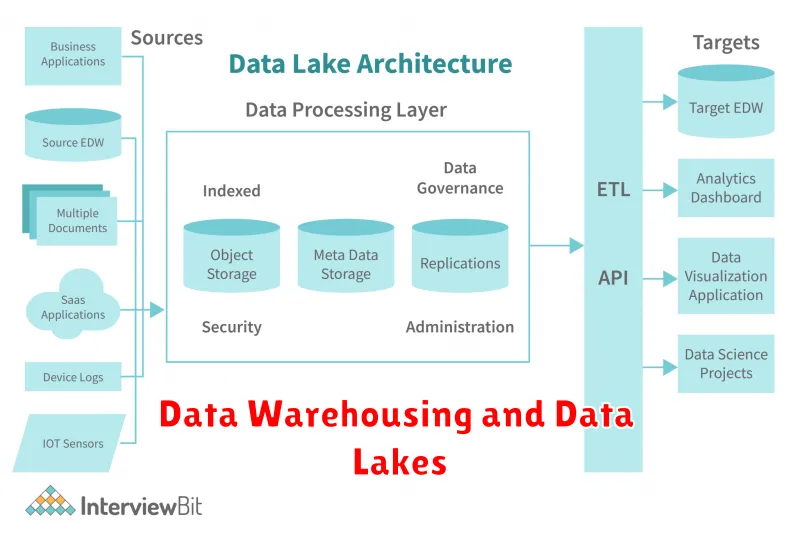
Big data analytics relies heavily on robust infrastructure to store, process, and analyze vast volumes of data. Data warehousing and data lakes are two fundamental approaches that play a crucial role in this process.
A data warehouse is a centralized repository designed for analytical purposes. It stores structured data from various sources, transformed into a consistent format for reporting and analysis. Data warehouses are optimized for querying and retrieval, enabling users to gain insights into historical trends and patterns.
In contrast, a data lake is a raw data storage system that embraces both structured and unstructured data. It offers a flexible and scalable approach, allowing organizations to store data in its original format without pre-defined schemas. This enables businesses to leverage diverse data sources, including logs, social media feeds, and sensor data, for advanced analytics.
The choice between data warehousing and data lakes depends on specific business needs. Data warehouses excel in providing a structured and consolidated view of data, ideal for reporting and decision-making based on historical data. Data lakes, on the other hand, offer greater flexibility and scalability, supporting advanced analytics, machine learning, and data exploration.
In modern data analytics environments, the integration of data warehousing and data lakes is becoming increasingly common. This hybrid approach leverages the strengths of both systems, enabling organizations to access and analyze a broader range of data sources for richer insights and improved business outcomes.
Data Mining and Machine Learning Algorithms
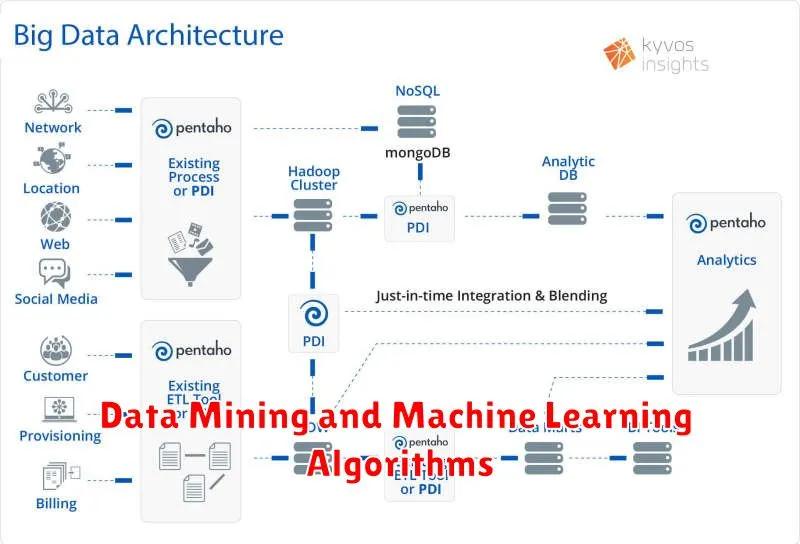
Data mining and machine learning algorithms are the backbone of big data analytics, enabling businesses to extract valuable insights and drive impactful decisions. These algorithms empower organizations to identify patterns, predict future trends, and uncover hidden relationships within massive datasets.
Supervised Learning Algorithms, such as linear regression, logistic regression, and decision trees, are used when there is a clear target variable to predict. These algorithms learn from labeled data, where each data point is associated with a known output. For example, predicting customer churn or identifying fraudulent transactions.
Unsupervised Learning Algorithms, including clustering, dimensionality reduction, and association rule mining, work with unlabeled data. These algorithms discover hidden patterns and structures without any prior knowledge of the output. For instance, segmenting customers based on their buying behavior or identifying product recommendations.
Reinforcement Learning Algorithms, like Q-learning and deep reinforcement learning, are used to train agents to make optimal decisions in dynamic environments. These algorithms learn through trial and error, receiving feedback in the form of rewards or penalties. Examples include optimizing pricing strategies or controlling robot movements.
By leveraging the power of data mining and machine learning algorithms, businesses can gain a competitive edge, enhance customer experience, and make more informed decisions. These algorithms are essential tools for unlocking the potential of big data and transforming raw information into actionable insights.
Real-Time Big Data Analytics
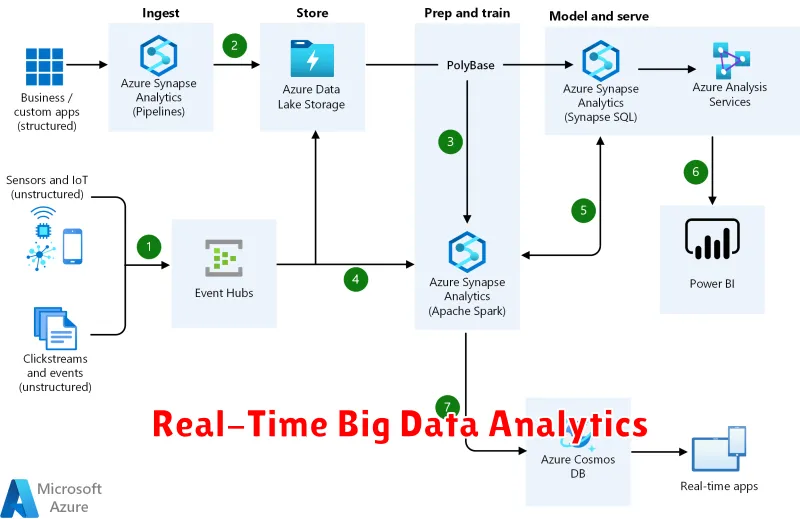
Real-time big data analytics is a critical aspect of modern business intelligence. It involves the analysis of large volumes of data as it is generated, allowing organizations to gain insights and make decisions in the moment. This capability is crucial for industries like finance, retail, and manufacturing, where rapid response to changing market conditions is essential for success.
The ability to analyze data in real-time enables businesses to:
- Identify and respond to emerging trends: By tracking data streams in real-time, organizations can spot new patterns and shifts in customer behavior, market trends, or competitor activities. This allows them to quickly adapt their strategies and capitalize on opportunities.
- Improve operational efficiency: Real-time analytics can help identify bottlenecks and inefficiencies in production processes, supply chains, or customer service operations. This allows businesses to make adjustments and optimize performance in real-time, reducing costs and improving overall efficiency.
- Enhance customer experience: By analyzing customer interactions and feedback in real-time, businesses can personalize their offerings and provide a more tailored and responsive experience. This can lead to increased customer satisfaction and loyalty.
- Reduce risk and prevent fraud: Real-time anomaly detection can identify suspicious activities and potential threats in financial transactions, security systems, or other critical processes. This helps organizations mitigate risks and prevent fraud in real-time.
The power of real-time big data analytics lies in its ability to transform data into actionable insights that can drive immediate business value. By leveraging this capability, organizations can gain a competitive edge, improve decision-making, and ultimately achieve greater success in today’s dynamic business environment.

